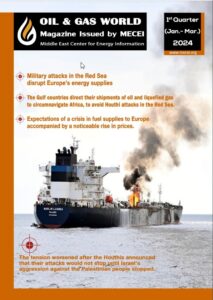- QatarEnergy selects Nakilat to own and operate 25 conventional LNG vessels
- The joint development of the Dorra field between Saudi Arabia and Kuwait is pending the demarcation of the border with Iran
- Minister of Energy reaffirms the UAE’s commitment to adopting clean energy and supporting the Paris Agreement
- The new Hassi Messaoud refinery enjoys the support of the government and President Tebboune
- Increasing electrical interconnection capacities to export electricity beyond borders
- Qatar Energy stops sending liquefied gas tankers through the Red Sea for security reasons
- The inauguration of the Duqm Refinery, the largest joint Gulf project in the refinery sector
- Saudi oil exports are faltering due to Houthi attacks on ships in the Red Sea and Gulf of Aden
- Algeria to host and chair the Gas Exporting Countries Forum summit (February 29 to March 2, 2024)
- Egypt Energy Conference and Exhibition 2024 gives a strong impetus to the global energy dialogue

Basic Concepts of World Petroleum Reserves (and the debate on its adequacy to achieve global energy security)


Mohamed Hassan Salem
Oil and Gas Economic Expert
Head of “Middle East Center for Energy Information”
Head of Oil & Gas World Magazine
Oil industry experts agree on the extreme difficulty of estimating global oil reserves. Most of these experts realize that the traditional reserve figures published by the credible sources of estimating reserves are starting to slow year after year in a worrying manner and threatening the security of global energy supply.
The concepts of oil reserves:
The experts allocate the world oil reserves according to the degree of certainty in extracting them from the land (Certainty) into three sections: Proven reserves, Probable reserves, and Possible reserves.
The estimate of reserves of all types (proven, probable and possible) is based on the available geological and geological data, but the degree of certainty is differentiated. The Proven reserves are at the highest levels of certainty, followed by Probable reserves then Possible reserves.
Proved Reserves are reserves with a high degree of certainty of at least 90% of their recoverability under existing economic and political conditions and using the prevailing technology at the time. In simpler terms, the reserves can be technically extracted at an acceptable cost under the current price of oil. This means that price changes lead to changes in the same direction in the drilling and exploration activities and thus in the volume of reserves.
For example, the increase in oil prices at certain periods encouraged international oil companies to expand their drilling and exploration activities in different regions of the world, resulting in an increase in global reserves. The laws in developed countries require the oil companies listed on their international stock exchanges to use only proven (proven) reserves to inform investors of their position. However, other governments and national oil companies have no obligation to prove their position to their investors with proven reserves figures.
Probable reserves are the recoverable reserves with a 50% certainty and are symbolized by the symbol P50. The Possible reserves are the recoverable reserves of 10% with the symbol P10. The total Proven and Probable reserves together denote the symbol (2P). The total of Proven, Probable and Possible reserves reflects all technically recoverable oil resources, regardless of price (3P).
The age/ life time of oil reserves:
The Reserve/Production Ratio is the most common indicator of the adequacy of the reserves or the extent of their coverage of the annual production rate, which gives the life time of the remaining proven reserves according to current production rates. Based on current production rates, the current lifetime of global crude oil reserves is estimated at around 50 years.
World oil reserves between optimists and pessimists
Some industry experts believe that the discovery of large oilfields (such as the Ghawar fields in Saudi Arabia and Rumaila in Iraq and Burqan in Kuwait) has ended without return, and that the fact that oil is a depleted resource cannot be avoided. They concluded that the world is rapidly approaching the time when new discoveries will be unable to compensate the ongoing depletion, an issue that threatens global energy security and causes severe damage to countries around the world, especially developed countries.
On the other hand, another group of experts suggests that it is not prudent to rely entirely on the size of proven reserves as they are not the single indicator of future supplies. In other words, it is not right to ignore the size and distribution of the probable and possible reserves that are surpassing the size of proven reserves concentrating in the Middle East.They also believe that it is not wise to ignore the large quantities of non-conventional oils found in some countries of the world. It is therefore difficult to ignore about 5 trillion barrels of proven and recoverable reserves, which is more than three times the proven reserves currently available, and sufficient to cover the world’s oil needs for more than 150 years. This makes the oil-depletion crisis not so imminent to justify concerns about the future of global supplies
Overestimation of reserves:
Global oil reserves have seen significant increases in some previous years because of exaggerations in estimating the proven reserves of some OPEC countries in order to influence the decisions of the Organization and in order to obtain higher production quotas for these countries of the total production of the Organization. Venezuela, a member state of the Organization, has also added heavy oils of about 99 billion barrels to its proven reserves of traditional oil in 2008, adding significant increases to global reserves. The OPEC countries also followed encouraging policies and applications in their oil sectors in those years, which had a clear effect on the growth of the world’s oil reserves, which now exceeds 1700 billion barrels, of which 1220 billion barrels are in OPEC countries (72%).
Countries with huge oil reserves:
The Organization of Petroleum Exporting Countries (OPEC) recently revised oil reserves estimates in member countries. Venezuela is at the forefront of the world (298 billion barrels) instead of Saudi Arabia (267 billion).
However, some analysts and experts underestimate the importance of reserves added by Venezuela, because the majority of these reserves of the quality of heavy oil and in places far and difficult and requires extraction of large investments. Venezuela has topped the world’s largest oil reserve with 298 billion barrels, followed by Saudi Arabia (267), Canada (173), Iran (158), Iraq (150), Russia (103) , Kuwait (102), the United Arab Emirates (98) and the United States (50).
Reserves and Future Supply:
The decline in oil prices recently led to a decline in drilling and exploration investments in the traditional oil sector, which raised concerns and fears about the future and the adequacy of oil reserves to secure world energy supplies.
The traditional oil industry has become in dire need of large investments, especially in the fields of exploration and production, to increase the volume of oil reserves and meet the growing demand for oil. Without high investments, the growth of reserves will slow and production rates will decline. The International Energy Agency estimates that oil production will fall by 9% annually if new investments are not injected to increase oil production. Moreover, the increase in global oil reserves will often come from exploration in difficult areas and deep waters that require huge investments.
On the other hand, unlike the recession experienced by conventional drilling and exploration, the oil shale industry in the United States is growing rapidly and its investments have increasing sharply, with its production increasing because of lower costs of shale production by 50% since 2014. In this regard, the International Energy Agency sees that this growth in the production of American shale oil has become a key factor in offsetting low activity in the traditional oil industry and thus in achieving balance in the global oil market.









